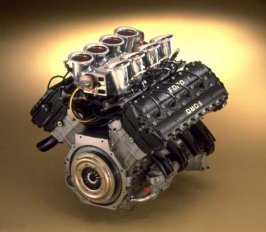- 87,622

- Rule 12
- GTP_Famine
FirebirdI don't know what that means, precisely. From what I can tell, you could opt for the Nissan's DOHC engine and have the best city fuel economy and tie for greenhouse gas emissions, or you could opt for GM's "antiquated" V8 which does everything as well or better (save city fuel economy) than the fancy-schmancy DOHC-job, including over 100 more ponies to play with.
Spearman's Rank says that the GM V8 doesn't, in fact, do everything "as well or better". Spearman's Rank says that the Nissan 350Z does everything "as well or better".
It helps, when you post statistics, that you can interpret them correctly.
FirebirdSo, which cars did this mythical 4.0L OHV V8 appear in? (emphasis on the sixes above)
I'm sorry? Who said anything about a 4.0 OHV V8? I mentioned that the Australians take OHV V8s from their parent companies and develop them into OHC V8s. I ALSO pointed out that, contrary to your claim of:
Firebird(there hasn't been a single Ford or GM engine reworked from OHV to OHC by their respective Australian subsidiaries)
The Typhoon/Falcon use a reworked OHC 4.0 6 based on the Ford parent company's OHV 4.0 6. So in fact there HAS been at least one Ford or GM engine reworked from OHV to OHC by their respective Australian subsidiaries.
FirebirdThe ones I've talked to agree that specific output is advertising fluff for the most part. I've also consulted myself on the subject. Coincidentally, I agreed with myself. Although I'm still a mechanical engineering student who probably doesn't know as much about mechanical engineering as someone with a B.Sc. and M.Sc. in molecular biology and genetics and human genetics and disease, respectively.
Hey! You can name my degrees! Good on you! What relevance does this have?
Student = someone who studies.
Now, who is talking about "specific output" on its own? My statement is:
"Pushrod <- SOHC <- DOHC. DOHC can produce more power and more torque per unit displacement more efficiently and more reliably."
If you disagree with that you are, frankly, wrong. All that the random examples you picked out of the air show is that some pushrods produce more power than some DOHCs and some pushrods have a better fuel economy than DOHCs - showing a remarkable lack of understanding, for a mechanical engineering student, of the word "efficiency".
All power output is, to use your phrase, "advertising fluff". Why would Chevrolet post "400" horsepower if not to use that nice, big, round number. But you're just NOT getting it. DOHC CAN produce more power and more torque per unit displacement more efficiently and more reliably than OHV. Some manufacturers choose not to take advantage of the "more power" or "more torque", but instead take advantage of "more efficiently" and "more reliably". Some manufacturers choose to do it the other way round. Some manufacturers choose to use OHVs instead - although rarely in Europe. None of this alters the basic fact that the DOHC is more capable of producing more stuff better.
Out of interest, seeing as you're a mechanical engineering student, what is the throttle response like on a typical OHC compared to OHV? Just out of curiousity (not fishing) since I don't actually know.








 Oh well,nothing a Good 'ol 305 Cubic inch OHV V8 won't fix...
Oh well,nothing a Good 'ol 305 Cubic inch OHV V8 won't fix... 

